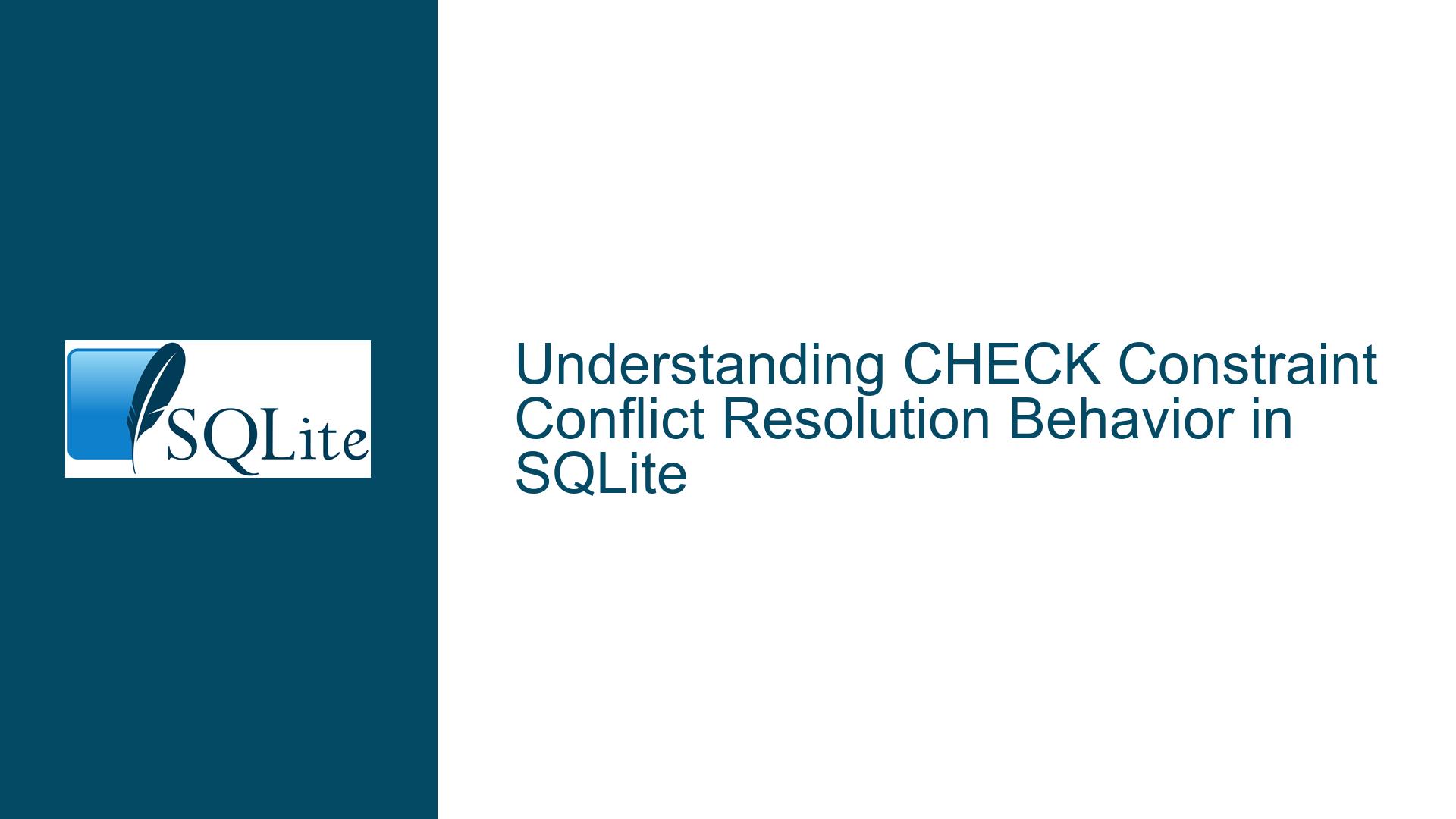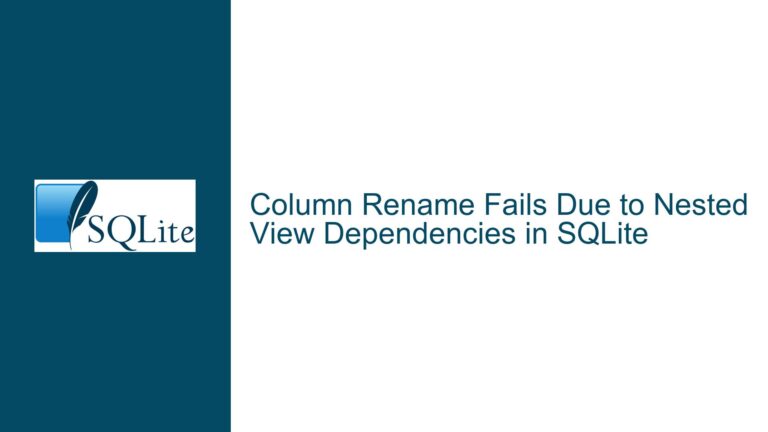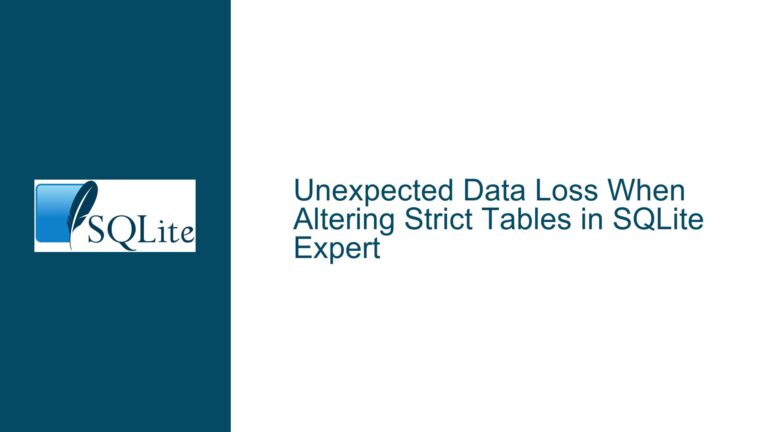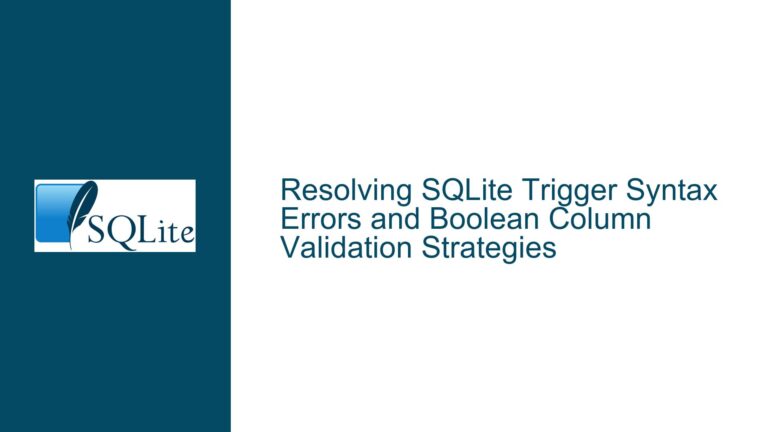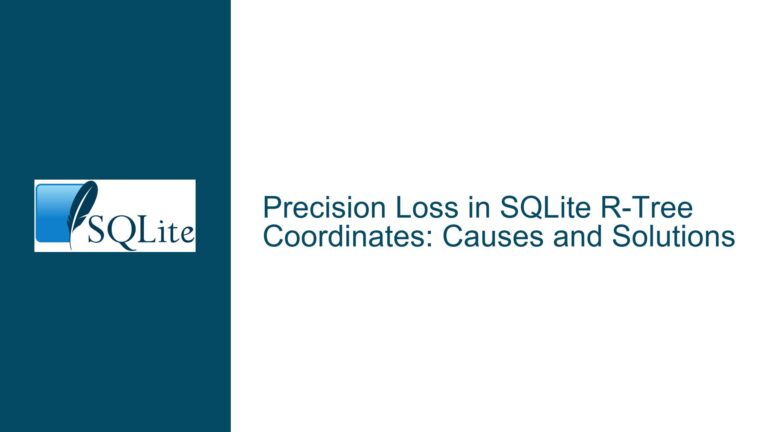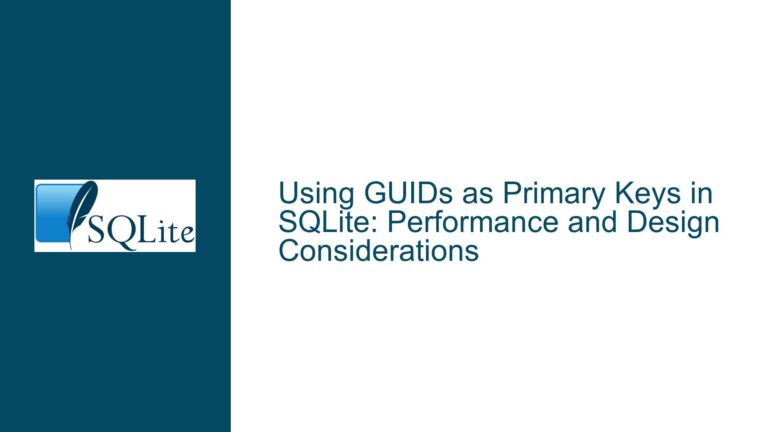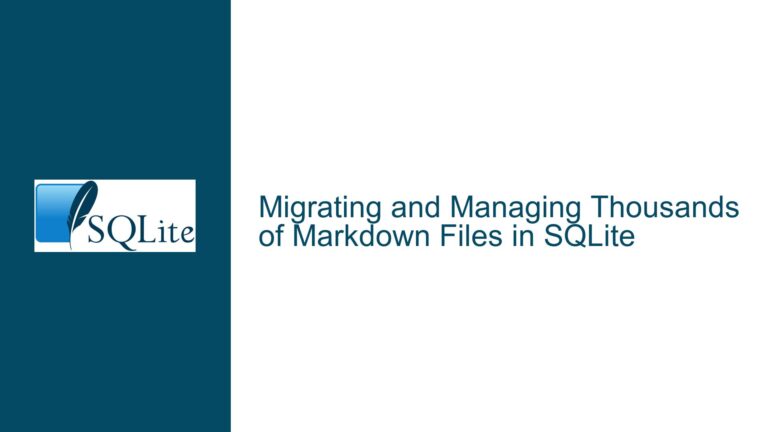CHECK Constraint Conflict Resolution Behavior in SQLite
CHECK Constraint Enforcement and Conflict Handling Semantics
The core challenge arises when attempting to define automatic conflict resolution strategies for CHECK constraints during table creation. While SQLite’s parser accepts the ON CONFLICT clause syntax when applied to CHECK constraints, runtime behavior demonstrates these clauses are ignored during constraint enforcement. This creates a discrepancy between syntactic validity and operational functionality. The fundamental issue resides in SQLite’s constraint hierarchy and how different constraint types handle violation resolutions.
CHECK constraints operate as row-level validation rules rather than database integrity constraints that interact with underlying storage structures. When a CHECK constraint fails, SQLite interprets this as an unqualified data validation error rather than a resolvable conflict. This distinction explains why explicitly declared ON CONFLICT clauses for CHECK constraints are parsed without error but remain non-functional during data modification operations. The database engine treats CHECK constraint failures as unconditional errors that bypass the conflict resolution framework applied to unique/PK constraints.
Parser Permissiveness vs. Runtime Constraint Enforcement
Three primary factors contribute to this observed behavior:
1. Constraint Type Hierarchy in SQLite
SQLite categorizes constraints into two operational classes:
- Structural Integrity Constraints: UNIQUE, PRIMARY KEY, FOREIGN KEY
- Data Validation Constraints: CHECK, DEFAULT
Conflict resolution clauses (ON CONFLICT) only affect structural integrity constraints that interact with index management and storage layer conflicts. CHECK constraints exist in a separate validation layer that short-circuits row processing upon failure without engaging the conflict resolution subsystem.
2. Prepared Statement Compilation
The SQL parser validates syntax without binding constraint clauses to specific enforcement mechanisms. This allows syntactically valid but semantically meaningless clauses like CHECK ... ON CONFLICT to pass through parse phases. The subsequent code generation phase for constraint enforcement ignores these clauses for CHECK constraints, resulting in their operational irrelevance.
3. Historical Compatibility Factors
SQLite maintains backward compatibility with legacy schema definitions, preserving the ability to parse constraint clauses that may have been meaningful in older versions or other SQL dialects. This permissive parsing prevents breaking existing schemas but creates situations where syntactically valid constructs lack runtime support.
Implementing Workarounds for CHECK Constraint Conflict Management
1. Explicit Conflict Resolution in DML Statements
Modify all INSERT/UPDATE operations to include explicit conflict resolution:
INSERT OR IGNORE INTO tbl VALUES (3);
UPDATE OR IGNORE tbl SET val = ...;
This approach bypasses the need for schema-level conflict resolution by handling constraint violations at the statement level. The OR IGNORE clause suppresses errors from all constraint types, including CHECK constraints. For production systems, implement wrapper functions or prepared statement templates that automatically append the appropriate conflict resolution clause.
2. Session-Level CHECK Constraint Suppression
Use PRAGMA directives to temporarily disable CHECK constraint enforcement:
PRAGMA ignore_check_constraints = ON;
-- Perform constrained operations
PRAGMA ignore_check_constraints = OFF;
This method completely disables CHECK constraint validation for the database connection. While effective for bulk operations, it introduces significant data integrity risks and requires careful transaction management. Not recommended for systems with concurrent write operations or schemas requiring strong data validation.
3. Trigger-Based Constraint Management
Implement INSTEAD OF triggers to enforce CHECK logic with custom conflict handling:
CREATE TRIGGER tbl_insert_check
BEFORE INSERT ON tbl
FOR EACH ROW
WHEN NEW.rowid > 2
BEGIN
SELECT RAISE(IGNORE);
END;
This trigger-based approach mimics CHECK constraint behavior while allowing silent failure modes. The RAISE(IGNORE) aborts the current insert/update operation without generating an error. Maintain schema documentation rigorously when using this method, as the constraint logic becomes distributed between the schema and trigger definitions.
4. View-Based Access Control
Create updatable views with CHECK OPTION that wrap base tables:
CREATE VIEW tbl_view AS
SELECT * FROM tbl
WHERE rowid <= 2
WITH CHECK OPTION;
Perform all data modifications through the view, which automatically filters invalid rows. The CHECK OPTION ensures that inserts/updates through the view satisfy the view’s WHERE clause. This method provides strong encapsulation but requires careful privilege management and may impact query optimization paths.
5. Schema Redesign with Partitioned Tables
Leverage SQLite’s table partitioning capabilities:
CREATE TABLE tbl_legit (
val INTEGER
);
CREATE TABLE tbl_overflow (
val INTEGER
);
-- Create unified access view
CREATE VIEW tbl AS
SELECT * FROM tbl_legit
UNION ALL
SELECT * FROM tbl_overflow WHERE 0;
Direct writes to tbl_legit with standard INSERTs, while implementing a trigger to redirect overflow rows:
CREATE TRIGGER tbl_partition
BEFORE INSERT ON tbl_legit
FOR EACH ROW
WHEN (SELECT count(*) FROM tbl_legit) >= 2
BEGIN
INSERT INTO tbl_overflow VALUES (NEW.val);
SELECT RAISE(IGNORE);
END;
This maintains the logical table structure while physically partitioning data. Queries against the view automatically include/exclude overflow data based on the UNION ALL structure.
6. Connection Wrapper Implementation
Develop a database connection wrapper that intercepts all write operations:
- Parse incoming INSERT/UPDATE statements
- Pre-validate against CHECK constraints
- Apply custom conflict resolution logic
- Execute modified statements with appropriate OR clauses
This architecture centralizes conflict handling while maintaining schema portability. Implement with caution in concurrent environments, ensuring proper transaction isolation levels.
7. SQLite Runtime Modification (Advanced)
For embedded deployments with control over the SQLite build, modify the CHECK constraint handling in the SQLite source code:
- Locate the
sqlite3VdbeCheckFkfunction in vdbe.c - Modify constraint violation handling in
sqlite3HaltConstraint - Add conflict resolution checks in
sqlite3VdbeExec
This approach requires deep C programming knowledge and voids SQLite’s public API guarantees. Only recommended for specialized deployments with rigorous testing requirements.
Performance Considerations:
- Trigger-based solutions add per-row overhead
- View-based approaches may complicate query optimization
- Connection wrappers introduce network latency in client-server models
- OR IGNORE clauses prevent batch operation optimizations
Data Integrity Implications:
- PRAGMA ignore_check_constraints affects all CHECK constraints
- Trigger solutions require comprehensive testing
- Partitioned designs complicate transactional boundaries
- View-based access can be bypassed with direct table writes
Migration Strategy:
- Audit existing schema and DML patterns
- Implement logging triggers to capture constraint violations
- Gradually introduce conflict resolution mechanisms
- Monitor performance and integrity metrics
- Phase out legacy write paths
Monitoring and Maintenance:
- Regularly query the
sqlite_mastertable for trigger/view definitions - Implement schema checksum validation
- Use EXPLAIN QUERY PLAN to analyze performance impacts
- Maintain version-controlled schema migration scripts
Cross-Database Considerations:
- PostgreSQL supports CHECK CONSTRAINT … NOT VALID for partial enforcement
- MySQL silently ignores CHECK constraints in default configurations
- Oracle implements CHECK constraints with full conflict resolution
- SQL Server allows check constraints with NOCHECK options
Alternative Architectures:
- Application-layer validation frameworks
- Middleware constraint enforcement
- Versioned schema with temporal tables
- Materialized view synchronization
Documentation Practices:
- Annotate triggers/views with cross-references to base table constraints
- Maintain data dictionary entries for all constraint workarounds
- Implement schema visualization tools
- Generate automated integrity reports
Testing Methodologies:
- Boundary condition testing for CHECK constraints
- Concurrency stress testing
- Rollback scenario validation
- Migration path verification
Long-Term Maintenance Risks:
- Trigger/view definition drift from base schema
- Performance degradation from layered abstractions
- Documentation obsolescence
- Version compatibility issues
Disaster Recovery Considerations:
- Include trigger/view definitions in backup routines
- Implement checksum validation for schema objects
- Maintain fallback schemas without abstraction layers
- Test constraint behavior during backup restoration
Security Implications:
- VIEW definitions expose partial data
- Trigger-based solutions expand attack surfaces
- PRAGMA usage requires connection security
- Wrapper implementations must prevent SQL injection
Compatibility Matrix:
| Solution | SQLite Versions | Portability | Complexity |
|---|---|---|---|
| DML OR Clauses | All | High | Low |
| PRAGMA Directive | 3.6.19+ | Low | Medium |
| Trigger-Based | 3.6.18+ | Medium | High |
| View Partitioning | 3.7.11+ | Medium | High |
| Connection Wrapper | All | Low | Very High |
| Source Modification | Custom Builds | None | Extreme |
Conclusion:
While SQLite’s permissive parsing allows syntax that suggests CHECK constraint conflict resolution capabilities, the current implementation (as of 3.39.4) does not honor ON CONFLICT clauses for CHECK constraints. Developers must choose between statement-level conflict resolution, trigger-based validation, or architectural workarounds to achieve similar functionality. The optimal solution depends on write pattern characteristics, performance requirements, and data integrity needs. Always validate constraint behavior through comprehensive testing rather than relying solely on schema declarations.
